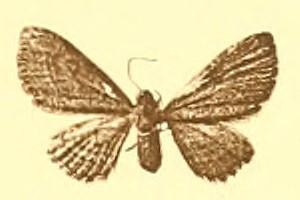Eupithecia nigrilinea is a moth in the family Geometridae. It is found in Afghanistan, Uzbekistan, Kyrgyzstan, Tajikistan, Pakistan, Jammu and Kashmir, Nepal and northern Thailand. The habitat consists of mountainous areas at altitudes ranging from 1,700 to 4,500 meters.
Eupithecia costipicta is a moth in the family Geometridae. It is found in Afghanistan, India (Sikkim) and China. The habitat consists of mountainous areas at altitudes between 2,300 and 3,500 meters.

Eupithecia barteli is a moth in the family Geometridae. It is found in Afghanistan, the southeastern part of European Russia, north-western Kazakhstan, Tajikistan, Nepal, India and China.
Eupithecia olgae is a moth in the family Geometridae. It is found in Uzbekistan, Kyrgyzstan, Tajikistan, Afghanistan, Pakistan, India, south-eastern Kazakhstan, China and Mongolia.
Eupithecia dalhousiensis is a moth in the family Geometridae. It is found in Afghanistan and the western Himalayas.
Eupithecia vetula is a moth in the family Geometridae. It is found in Afghanistan, Pakistan and India.
Eupithecia karnaliensis is a moth in the family Geometridae. It is found in Afghanistan, the Great Western Himalaya Mountains and Nepal. It is found at altitudes between 2,200 and 3,200 meters.
Eupithecia tabestana is a moth in the family Geometridae. It is found in eastern Afghanistan, northern Pakistan and central Nepal.
Eupithecia obtinens is a moth in the family Geometridae. It is found in Afghanistan and Iran.
Eupithecia fredi is a moth in the family Geometridae. It is found in eastern Afghanistan.
Eupithecia nepalata is a moth in the family Geometridae. It is found in Afghanistan, Tajikistan, northern Pakistan, northern India and Nepal. The habitat consists of mountainous areas.
Eupithecia parallelaria is a moth in the family Geometridae. It is found in Turkmenistan, Iran, eastern Afghanistan and Kashmir.
Eupithecia mitigata is a moth in the family Geometridae. It is found in Afghanistan, Tajikistan, Kyrgyzstan, southern Kazakhstan, north-western China (Xinjiang) and Kashmir.
Eupithecia tshimganica is a moth in the family Geometridae. It is found in Afghanistan, Uzbekistan and Tajikistan.
Eupithecia convallata is a moth in the family Geometridae. It is found in Afghanistan and Iran.
Eupithecia xanthomixta is a moth in the family Geometridae. It is found in Afghanistan and Iran.
Eupithecia nachadira is a moth in the family Geometridae. It is found in Afghanistan and Iran, as well as Ukraine.
Eupithecia decipiens is a moth in the family Geometridae. It is found in Afghanistan, Iran, Uzbekistan and Kyrgyzstan. It is found at altitudes between 1,500 and 2,900 meters.
Eupithecia ochrovittata is a moth in the family Geometridae. It is found in Afghanistan and the Transcaucasus.
Eupithecia exicterata is a moth in the family Geometridae. It is found in Afghanistan and the western Himalayas.